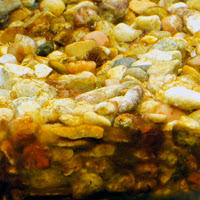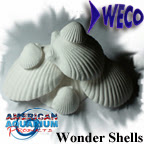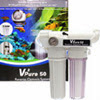Our Facebook Page to Follow: Aquarium/Pond Answers Facebook
This is a unique resource for answers, help, & advice to aquarium and pond questions not found elsewhere; With regular posts & article updates.
In our research; we use aquaculture, horticulture, medical, & university research to compile many of our articles.Our Recommended Lighting for highest efficiency professional planted/reef aquariums: "AquaRay Lighting"
Bio Load in Aquarium or Pond
By Carl Strohmeyer-PAMR 40+ years experience
Updated 3/20/19
The "Bio-Load" is essentially the amount of life existing in an aquarium, pond, etc. and its affect upon the nitrogen process that places demand upon the aquarium's filter system. This includes mechanical, chemical, and especially biological filtration.
Factors that affect this include waste, nutrients, dissolved organic particulates/compounds (DOC), bacteria, plankton, and more.
This applies to both Salt and Freshwater as well as ponds.
As well the "Bio Load" affects the bio system not associated with filters, which includes plants and nitrification/de-nitrification outside of the filters.
A lesser known aspect of the aquarium (or pond) bio load is its affect on the Aquarium Redox Balance, yet these two have major interconnections.
An example would be a Redox that moves up in down with large changes in ORP likely indicates an aquarium with too high a bio-load, often adding oxidative stress to the inhabitants thus shortening their lifespan and lowering disease resistance.
Further Reference: Aquarium Redox Reduction, Oxidation, Balance

This "bio-load" is made up of uneaten food, decomposing inhabitants, accumulated organics and waste produced by livestock, foods and plant matter in the aquarium tank/system.
Often this bio load goes unseen decomposing in filters, especially canister and large wet/dry sumps.
As well, this hidden bio-load may be under rocks and other decorations, especially live rock reefs in marine aquariums.
The picture to the left shows trapped decomposition from uneaten food and other organics. This adds to the bio load and can also affect the Redox Balance requiring abnormally high oxidation levels. (please click on the picture to enlarge for a better view)
 What is also noteworthy, while additional filtration will help handle a higher bio-load in an aquarium or pond, it is a finite number.
What is also noteworthy, while additional filtration will help handle a higher bio-load in an aquarium or pond, it is a finite number.
What I mean is, one cannot have a 60 gallon aquarium with say a Fluidized Sand Bed Filter/Reactor and a quality Sponge Filter, both of which are excellent bio filters (if not the best depending upon whether you purchased patented AAP Hydro Sponge or cheap Chinese knock off) and then say if I double these filters I can double the amount of fish so long as I keep up with dissolved oxygen levels in the aquarium!!
It simply does NOT work this way, as while good filtration and filter redundancy is definitely a plus, there is a point where too high of a bio load is too high a bio load!
This analogy goes for marine reef aquariums as well and in fact I have both observed and had dealt with customers with Marine Reef Aquariums whereby they thought their double Protein Skimmers and copious amounts of live rock would allow them to keep a very crowded reef tank. In the end, even the smallest changes would bring sudden changes in Redox or nitrate levels or even ammonia levels!
Product Resources:
*Patented High Bio Capacity Aquarium Sponge Filters, from AAP
*High Bio Capacity Aquarium Fluidized Sand Bed Filters/Reactors
ADVERTISEMENT

Water changes is probably the best way to TEMPORARILY deal with a bio load that is clearly past its capacity.
This water change can be a flow through method where-by clean, mineralized, de-chlorinated water is constantly being slowly changed out.
Further Reference: Aquarium Cleaning; Methods
The picture to the right is a feeder tank at a pet store. This is an example of an aquarium that is clearly over stock and past its bio-load capacity.
However before I seem to condemn this practice, as long as these criteria are met this can be done for the SHORT term:
- It is temporary (meaning fish are sold out in a matter of a few days),
- The fish are well fed prior to entering this tank, but are fed little for the few days within this temporary environment
- The water is changed out once or twice per day (the flow through method is best for this),
- FULL positive ion mineralization is provided
Reference: Aquarium Chemistry; Depletion of Mineral Ions - Heavy aeration,
- UV Sterilization is utilized
Further Reference: Aquarium UV Sterilization
These above methods will maintain a balanced Redox, meaning both oxidation and reduction, which results in the fish being healthy and less risk of disease introduction when moved or more likely fed to other fish.
I should point out that part of my reason for even posting and explaining this picture of "Feeder Fish" is simply to show how extreme we can get in bio load and where one should NEVER be with the maintenance of our PET fish.
As well this is meant to demonstrate what we can do if only temporary to deal with a high bio load.
And finally to point out that many fish/pet stores do NOT follow many or even any of the practices I note here to deal with this hopefully temporary extreme bio load condition.
 Another aspect of aquarium bio load is plants.
Another aspect of aquarium bio load is plants.
Plants certainly make for a more natural freshwater aquarium and in many ways are a better way to control many aspect of the nitrogen level since plants due not produce the nitric acid that nitrifying bacteria produce. Especially during daylight hours of photosynthesis plant increase oxygen.
However plants themselves can die and leave decomposing debris that adds to the waste aspect of an aquariums bio load.
As well during night when photosyntheis ceases, the plants will compete with fish for oxygen, so this is a consideration with a planted aquarium and its bio load.
With ponds, this becomes even a bigger issue as many outside plants that provide no benefit other than maybe shade can drop copious amounts of debris into a pond thus adding to decomposition.
An aquarium keeper should attempt to trim off as many dying or old plant leaves, and remove dead plant material from the bottom of an aquarium or pond.
If your tank has an algae problem, in particular a free floating algae problem, or if algae has been scraped off rocks, etc. into the water column, it is advisable to perform a water change and change/clean at least some filter media after such a scraping or use of a new UV Sterilizer to clear such an aquarium.
Overall, as with a filter, a well maintained heavily planted aquarium can increase the bio load capacity of an aquarium, but similar to additional filtrations, this is not a large increase.
This also applies to a Marine Reef Aquarium Refugium, whereby these definitely aid in nitrate control (& generally are an asset to any marine aquarium), but these also can add to bio load in other ways, especially if poorly maintained.
A few water parameters to watch as an indicator of a "too high" bio load are:
- Nitrates that are difficult to control.
This of course is rather subjective since methods used to control nitrates themselves have a tendency to vary from aquarium to aquarium.
As a generalization, if your tank is employing many of the methods found in this article below, yet nitrate numbers under 15 ppm are still often evasive, you likely have a bio load problem.
Reference: Controlling Aquarium Nitrates
It is noteworthy that one of the methods listed in this above referenced article of controlling nitrates IS LOWERING Bio-Load - Redox Balance.
Bio load has both direct and indirect affects on the Aquarium Redox or ORP.
The direct effect is that this bio load will require more of the oxidation side of the Redox equation.
What I would call an indirect affect is that while your aquarium might be stable with the ORP (Redox), a sudden change to this equation could add the stimulus to change this balance since it was already hanging by a thread (so to speak) as per a high bio load.
This would be especially common with an advanced Reef aquarium where abundant methods of nitrate reductions are keeping the nitrates in check, yet masking a very high bio load.
Adding too much Calcium Hydroxide or another sudden change in mineral ions could be this stimulus.
Further Reference: Aquarium Chemistry, Kalkwasser, Calcium Hydroxide
The addition of a UV Sterilizer could also affect this balance too.
While this might seem to fly in the face of recommendations of using a UV Sterilizer, this does not mean you should permanently cease the use of this device.
What UV-C Sterilization operating at level 1 or level 2 does, is the UVC energy reacts within the Sterilizer chamber to neutralize many oxidizers similar to how ozone and UVC react in the upper atmosphere.
The result is improved immunity for your fish since excess oxidizers in the water column can be detrimental to your fish' long term health.
So my point is lower your Bio Load before you trash your UV Sterilizer.
Please See: Aquarium Redox; possible Problems
Here is a quote from this article: "the addition of a UV Sterilizer can play an important role for a balanced aquatic Redox Potential as newer studies have proven that UV Sterilization increases immunity by adding electrons and balancing the essential electromagnetism of the water"
Product Resource: Level 1 & 2 Aquarium UV Sterilizers - The clarity or color of the water can occasionally be an indicator.
Assuming peat, certain driftwood, Indian Almond leaves are not being used (in a freshwater aquarium), your aquarium should only be slightly yellow or slightly green, but otherwise easy to see through.
Otherwise this too might be an indicator of a "too high" bio-load.
High Algae growth MAY be an indicator, more so if the algae is free floating assuming the lighting is correct.
Another occasional indicator is a sudden change in ORP due to the die off of algae from the use of a UV Sterilizer, this often will color the water in both marine and freshwater aquariums.
While this may indicate a high bio load, this problem may self correct with a simple change of water and cleaning of filters. - pH Stability; often an unstable pH, whether salt or freshwater is an indicator of too high a bio load. Often this shows with with an unstable KH/Alkalinity where-by higher than would be normal for a tank of a certain size amounts of alkaline buffers are require to maintain a stable pH and constant KH/Alkalinity
- Total Dissolved Solids (TDS); A TDS that jumps quickly after water changes without other outside influences can indicated a high bio load.
Finally, here is a ranking of filters that have from highest to lower in bio load capacity.
Please note that while this is an objective list based on ounce per ounce of bio capacity, it does NOT take into account different sizes of these filters or in the case of canister filters or wet/dry sump filters the type of filter media used (although I do break this up as best as possible).
- Fluidized Sand Bed Filter/Reactor; Pound per pound there is NO higher bio capacity filter available. When used with specific medias such as Bio Plastics, it is also an excellent nitrate remover.
- Wet/Dry Sump Filter; set up with SeaChem Matrix, live rock or volcanic rock along with sponges and refugium or nitrate removing mud filter
- Canister Filter; set up with SeaChem Matrix, live rock or volcanic rock along with SeaChem Purigen or related products.
- Patented AAP Hydro Sponge Filters; excellent nitrifying filters ounce per ounce (actually only exceeded by FSB Filters for this aspect of bio capacity), but little de-nitrification ability.
The Chinese sponge filter knock offs have as little as 1/5 the capacity!! - Wet/Dry Sump Filter; standard set up with bio balls. Good to excellent nitrifying bio capacity, but little de-nitrification ability.
- Canister Filter; with standard configuration. Good to excellent nitrifying bio capacity, but little de-nitrification ability.
- HOB Filters; there are so many brands here with very different variables that rating these alone could take its own review which is beyond the scope of this article.
Suffice to say the Aqua Clear is one of the best, while the many brands sold at discounters with only a cartridge are among the worst. - Common or DIY Sponge Filters; fair to good nitrifying filters ounce per ounce (actually only exceeded by FSB Filters for this aspect of bio capacity), but little de-nitrification ability.
The difference in these sponge filters is much less pore to contain nitrifying bacteria and also a tendency to clog much more quickly than patented Hydro Sponge Filters (as per my tests in the 1990s).
Simple rinsings will show the capacity or the patented AAP Hydro Sponge Filters to be as much as 5 times!! - Corner Filters; generally little bio capacity
Here is an excellent article that addresses in much more depth the advantages of the above mentioned filters (especially the differences in HOB filters):
Aquarium Filtration; Filter Review
Other Recommended Reference & Product Sites

Aquarium or Pond UV Sterilization

Algone Water Clarifier & Nitrate Remover
An awesome USA made product; Nitrate fixating microorganisms incorporate excess nitrogen into the cellular mass, while bioactive enzymes assimilate nitrogen from the water column

EcoSense ORP 15 Redox Meter
ORP Range -1200 to +1200 mV
Great for testing Redox before and after water changes, use of water conditioners, after addition of UV Sterilizer, etc.

Wonder Shells, Regular & Medicated
Unique Version sold ONLY at American Aquarium Products.
Excellent for disease prevention!!!
TMC V2 RO Filter systems; the very best you can buy with TDS meter (far superior to 4 stage RO/DI systems sold via Bulk Reef Supply, Amazon, or eBay that use the inferior cellulose triacetate membrane made by Dow):
 Reverse Osmosis Aquarium Water Filters; with TDS Meter
Reverse Osmosis Aquarium Water Filters; with TDS Meter
ADVERTISEMENT
Labels: Aquarium Bio load, aquarium nitrates, aquarium redox, Bio Load, fish bio load, planted aquarium bio load, pond bio load, reef aquarium, reef aquarium bio load












